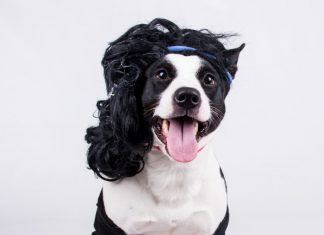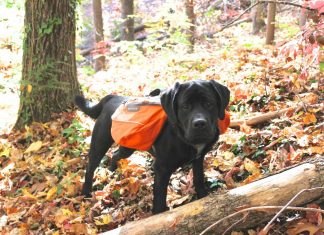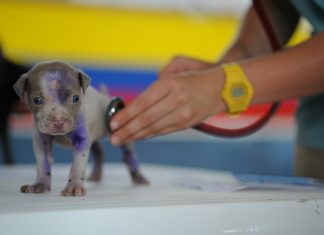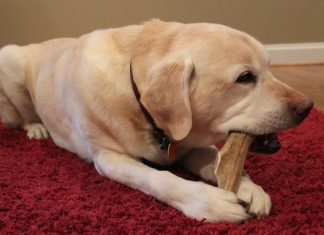What’s mine is mine; what’s yours is mine; what I found is mine; YOU are mine; and what I stole is mine too! This is the mindset of a 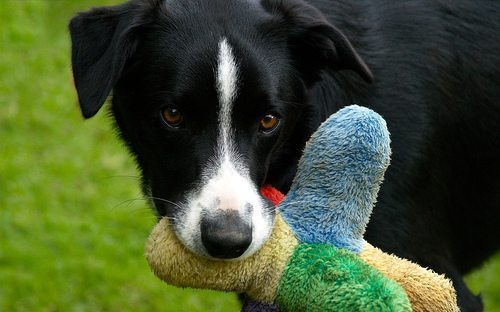
typical dog. Dogs are resource guarding creatures by design; if they had shared everything before domestication, they would be an extinct species. Despite the domestication of canines, the resource guarding gene remains active. It is stronger in some dogs than others, but the tendency remains.
Do humans have anything to do with this tendency? I believe that we do. The first thing we teach our teething puppies is that practically everything they put in their mouths is going to be taken away from them! Picture this: you take your puppy outside to go potty. He sees some interesting wood chips or a dead worm and picks it up. What do we do? Well, we get it away from him, of course! Puppy might swallow it and get sick! Finally, your puppy goes potty and you take him inside to play for a while. Oops, he just grabbed your glasses and is about to chew them up – quick, get them before he ruins them! The scenario for puppies often plays out just like this – whatever I get, my human takes it away. This quickly teaches the puppy to run whenever he finds something, and it will usually be something with your scent on it (the remote, your cell phone, gloves, shoes, etc.). Now the puppy has learned to engage you in play – “come and chase me (yeah, attention for me!) and see if you can get it!”
Fast forward about six months, and let’s look at your adolescent puppy. He is cutting his back molars now and seems to be chewing things more than in recent weeks. You walk in to the living room and see puppy happily chewing on the television remote. You swiftly walk over to take it away and Fido growls at you. What is this? You scold him immediately and get the remote away from him, all the while wondering what has gotten into your sweet puppy. This same or a similar scenario happens a few more times; puppy has something and growls at you or a family member when you try to take it away. You make sure he knows that his behavior is NOT acceptable and find various forms of punishment to inflict whenever the situation occurs. Now, it is likely that this dog will eventually bite when he feels something is about to be taken away from him. Unknowingly, you have created this problem!
There are two things that this puppy has learned in his less than one year of life with humans: 1) whatever I get will get taken from me and 2) when I feel threatened and try to express that (by growling), I get in big trouble, so I am not supposed to growl.
What most humans don’t realize is that a growl is the only way your dog can communicate to you that he is uncomfortable and that he wants the threat to stop.
When we teach a dog that growling is not ok, then the next step for the dog is to bite.
The Solution
Let’s start over – and look at our puppy.
First, manage your puppy’s environment. Make sure he is in a contained area such as a puppy pen where he has appropriate toys and chew items at every turn.
Teaching your puppy to drop something on cue is fun and easy.
Here are the steps to teach “drop”:
• Start with some appropriate chew items like a bully stick or a hoof.
• Have some tiny cut-up pieces of hot dog or roast beef.
• Wait until your puppy is happily chewing on his bully stick.
• Take a piece of hot dog and place it on your puppy’s nose, less than 1/2 inch away.
• Wait for him to take his mouth off of the bully stick and look at the treat.
• Move the piece of hot dog about two feet away, luring your puppy with it.
• As you are giving your puppy the hot dog, take the bully stick with your other hand and place it behind your back.
• Once your puppy has finished the hot dog he will go back to get his bully stick.
• As soon as he does, present the bully stick to him and cheerfully say, “take it”!
Repeat these steps exactly as described above about a dozen times. Then, as you begin to place the treat at your dog’s nose, say “drop” and again wait for your puppy to release the chew item, and continue with the remaining steps.
As you practice this cue a couple of times each day (always with the appropriate item that you can give back to the puppy) the puppy will soon drop the item as soon as you say “drop”, without you placing the treat right in front of the puppy’s nose. You should continue to give the puppy the tasty treat and place the item behind your back for a moment, then give it back. Think about the logic here – why wouldn’t a puppy give you an item when you ask for it?!? After all, he not only gets something better (in his opinion), but he gets the shared item back as well. It’s a deal he cannot refuse! Your puppy will be happy to drop and take it whenever you ask. More importantly, you will have taught your puppy that there is no need to think that whatever he has is going to be taken away from him. He will learn there are things he can have – and the things that are off limits will become less important.
Note: If you have an adult dog who is growling when you try to take something away, or growls at you or someone who comes near him while he is eating, seek help from a professional. Resource guarding can be a serious threat to you and your dog, especially if it may lead to a bite.
Photo: Courtesy of Pixel Theif via Flickr (CC by 2.0)

